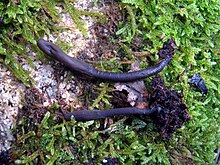en
names in breadcrumbs


Microglossum atropurpureum is a species of fungus in the family Leotiaceae. In the UK, it has been given the recommended English name of dark-purple earthtongue. Ascocarps (fruit bodies) are black, often with a purple tint, and are irregularly club-shaped. They occur in soil and resemble earth tongues, but are microscopically distinct. The species was formerly referred to the genus Geoglossum, but is not closely related to the Geoglossomycetes.[2]
Microglossum atropurpureum is found in eastern North America and Europe, where it is typical of waxcap grasslands, a declining habitat due to changing agricultural practices. As a result, the species is of global conservation concern and is listed as "vulnerable" on the IUCN Red List of Threatened Species.[1]
}
Microglossum atropurpureum is a species of fungus in the family Leotiaceae. In the UK, it has been given the recommended English name of dark-purple earthtongue. Ascocarps (fruit bodies) are black, often with a purple tint, and are irregularly club-shaped. They occur in soil and resemble earth tongues, but are microscopically distinct. The species was formerly referred to the genus Geoglossum, but is not closely related to the Geoglossomycetes.
Microglossum atropurpureum is found in eastern North America and Europe, where it is typical of waxcap grasslands, a declining habitat due to changing agricultural practices. As a result, the species is of global conservation concern and is listed as "vulnerable" on the IUCN Red List of Threatened Species.
Purpur-maakeel (Geoglossum atropurpureum) on seeneliik.
Ta on Eestis arvatud II kaitsekategooriasse (seisuga 2012).
Eestis võib teda leida paljudest metsatüüpidest ja ka aruniitudelt[1].

Purpur-maakeel (Geoglossum atropurpureum) on seeneliik.
Ta on Eestis arvatud II kaitsekategooriasse (seisuga 2012).
Eestis võib teda leida paljudest metsatüüpidest ja ka aruniitudelt.
Purpurbrun jordtunga (Geoglossum atropurpureum) je grzib[7], co go nojprzōd ôpisoł August Johann Georg Karl Batsch, a terŏźnõ nazwã doł mu Christiaan Hendrik Persoon 1796. Geoglossum atropurpureum nŏleży do zorty Geoglossum i familije Geoglossaceae.[8][9] Żŏdne podgatōnki niy sōm wymianowane we Catalogue of Life.[8]
Purpurbrun jordtunga (Geoglossum atropurpureum) je grzib, co go nojprzōd ôpisoł August Johann Georg Karl Batsch, a terŏźnõ nazwã doł mu Christiaan Hendrik Persoon 1796. Geoglossum atropurpureum nŏleży do zorty Geoglossum i familije Geoglossaceae. Żŏdne podgatōnki niy sōm wymianowane we Catalogue of Life.